Michigan vegetable crop report – May 24, 2023
If things were better, there’d be an investigation.
Weather
Watch Jeff Andresen’s weather update.
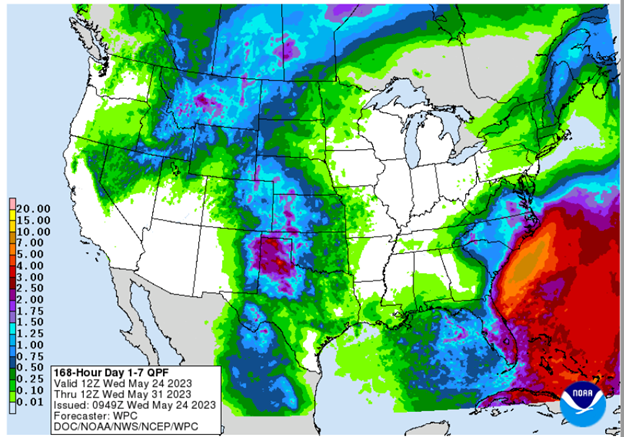
Last week was dry except for some 0.5-0.75-inch rains in northwest and southeast Michigan. Temperatures were cool, but degree day totals remain close to normal.
The forecast calls for:
- Mostly sunny, windy and much cooler Wednesday (May 24). Clear and cold overnight Wednesday with frost and freezing temperatures possible in the interior north areas Thursday morning.
- Fair and dry statewide Thursday through the weekend. Scattered light frost possible again Friday morning across the interior north.
- High temperatures from the upper 50s and 60s Wednesday and Thursday gradually warming back to the 70s to near 80 again by Friday through this weekend and into the 80s next week. Low temperatures from the upper 20s and 30s Thursday and Friday warming back to the 40s to 50s again this weekend.
- Medium range guidance calls for warmer and drier than normal weather and elevated PET rates for most of the next one to two weeks.
- New long lead outlooks call for normal to above normal precipitation totals for the summer months, with near equal odds of below-, near-, and above normal mean temperatures.
Irrigation considerations
Moist soils can buffer freezing temperatures to some degree, making irrigation potentially helpful ahead freezing temperatures. Beyond this short-term threat, using irrigation to germinate seed will be a hot topic for growers with the mid-term weather forecast. It is important to maintain the timing of things like sweet corn, green bean, pea and pickle emergence to reduce a harvest glut when several plantings pile up. When a seed germinates in a moist zone and sends its first roots down to anchor and find more moisture it is important to maintain a “wetted front” just ahead of the searching roots.
Forecasted Reference Evapotranspiration (FRET) is for 6-inch grass, and the forecast for the next week can be found on the Michigan State University Enviroweather Potential Evapotranspiration table. Select “Today” as the Start Accumulating date and it will forecast the accumulation of evapotranspiration for the next week, starting today. A crop coefficient is used to adapt the FRET to your crop at its current stage. The crop coefficient, often referred to as Kc, is used as a multiplier to make up the difference between 6-inch grass and the crop you are growing. A chart of fruit, vegetable and field crop coefficients (Kc) and root development is available from the MSU Biosystems & Agricultural Engineering website.
Example: With a Kc of 0.2 for corn at V-2 stage and FRET for this coming week of 1.094 inches in Benton Harbor, Michigan, the crop will use 0.21 inches of existing soil moisture, rain or supplemental irrigation. Since no rain is coming soon, half inch applications on sandy loam soil will assist in germination/emergence or incorporate/activate herbicides. Multiple applications may be needed with the predicted atmospheric conditions and to maintain the wetting front ahead of seedling root growth.
Sorghum sudangrass cover crop notes
This is a good time to consider planting sorghum sudangrass or other summer cover crops in fields that will not have vegetables this year. Sorghum sudangrass is the go-to cover crop for this purpose on many vegetable farms. It is a warm season grass that is excellent at both building soil organic matter and suppressing weeds over the summer months. However, success with this species depends on careful management. Here are a few tips to keep in mind:
Seed rates and weed suppression. Sorghum sudangrass should be drilled at a high rate to ensure adequate suppression of weeds. For example, in studies conducted in the Brainard lab at MSU, seeding rates of 50- 75 pounds per acre were needed to prevent pigweed species from producing large numbers of seeds under an otherwise healthy-looking sorghum sudangrass stand. These are higher rates than typically recommended and come at a cost, but this cost will likely be outweighed by the benefits of fewer headaches and weed management costs in the future. Using a drill rather than broadcasting is also highly recommended to help ensure the uniform coverage needed to prevent weeds from getting a foothold.
Mowing and biomass production. Keep in mind that on fertile ground sorghum- sudangrass may grow 10 feet tall and produce upwards of 5 tons of high-carbon dry matter per acre. While this biomass is good for building soil organic matter in the long run, it can also be a headache to incorporate, and may reduce availability of nitrogen to the subsequent crop. Therefore, it is usually advisable to mow sorghum-sudangrass once or twice (whenever it reaches around 3-4 feet) to maintain a greener, higher nitrogen residue. Mowing sorghum sudangrass is also reported to increase root penetration, which may be helpful for breaking up compaction layers. The impact of mowing on weeds is a bit complicated to predict, as some species may bounce back faster than the sorghum-sudangrass. However, if high seeding rates are used, weeds below the canopy tend to grow tall and spindly and are readily killed with mowing (a one-two punch!).
Cover crop mixtures with sorghum sudangrass. Sorghum sudangrass is sometimes recommended as part of a cover crop “cocktail” containing legumes (e.g., sunhemp or cowpea) and brassicas (e.g., radishes and yellow mustard). While such combinations may provide benefits, they should be avoided in fields where brassica and legume crops (e.g., cabbage, peas or beans) are part of the rotation. Otherwise, disease and insect pests may become a problem. In addition, note that because of its aggressive growth, sorghum-sudangrass will often dominate other species in mixtures. Many of those species may also not tolerate mowing.
For additional information on the benefits of sorghum sudangrass and tips on management, see the SARE publication Managing Cover Crops Profitably.
Preemergence herbicides and soil moisture
Preemergence herbicides play a very important role for production of any vegetable crops. Note that the activation of preemergence herbicide depends mainly on soil moisture and there isn’t a significant chance of rain in the forecast. It is important to have at least a half-inch of rain to activate the herbicide in order to move the product to the depth where germinating seeds are located. Here is a great article from Iowa State University Extension that explains the importance of soil moisture after application of preemergence herbicides. The rule of thumb is that if a field fails to receive an activating rain, consider applying irrigation within five to seven days of herbicide application.
Weed of the Week
Quackgrass (Elytrigia repens) is a perennial, cool-season grass found across Michigan. Key identification features are its blue-green leaves, auricles that “clasp” around the stem at the leaf collar and pointed rhizomes. Like Canada thistle or field bindweed, quackgrass can spread by rhizome growth, making it difficult to control once it is established. Emerging leaf blades can puncture plastic mulch and underground rhizome growth can pierce potato/sweet potato tubers.
Management through tillage can be insufficient because it can chop and spread the rhizomes, with each piece of rhizome having the potential to form a new plant. Tillage and cultivation provide the best results when they are used to bring rhizomes to the soil surface to dry out. Growing competitive cover crops for weed suppression can also help reduce stands early in the season.
Preemergence herbicides effective for quackgrass control include Aatrex (atrazine), Kerb (pronamide) and Solicam (norflurazon). The best post-emergent herbicides for quackgrass control are glyphosate products, Aatrex (atrazine), Accent (nicosulfuron) and Fusilade (fluazifop-p). If Fusilade is unavailable, other grass herbicides like Assure (quizalifop-p), Select Max (clethodim) and Poast (sethoxydim) also have activity on quackgrass. A fall application of Kerb, Fusilade and glyphosate can be very effective in managing quackgrass.
If you’re interested in learning more, check out this article from Cornell/SARE on quackgrass biology and control or this guide to non-chemical quackgrass control.
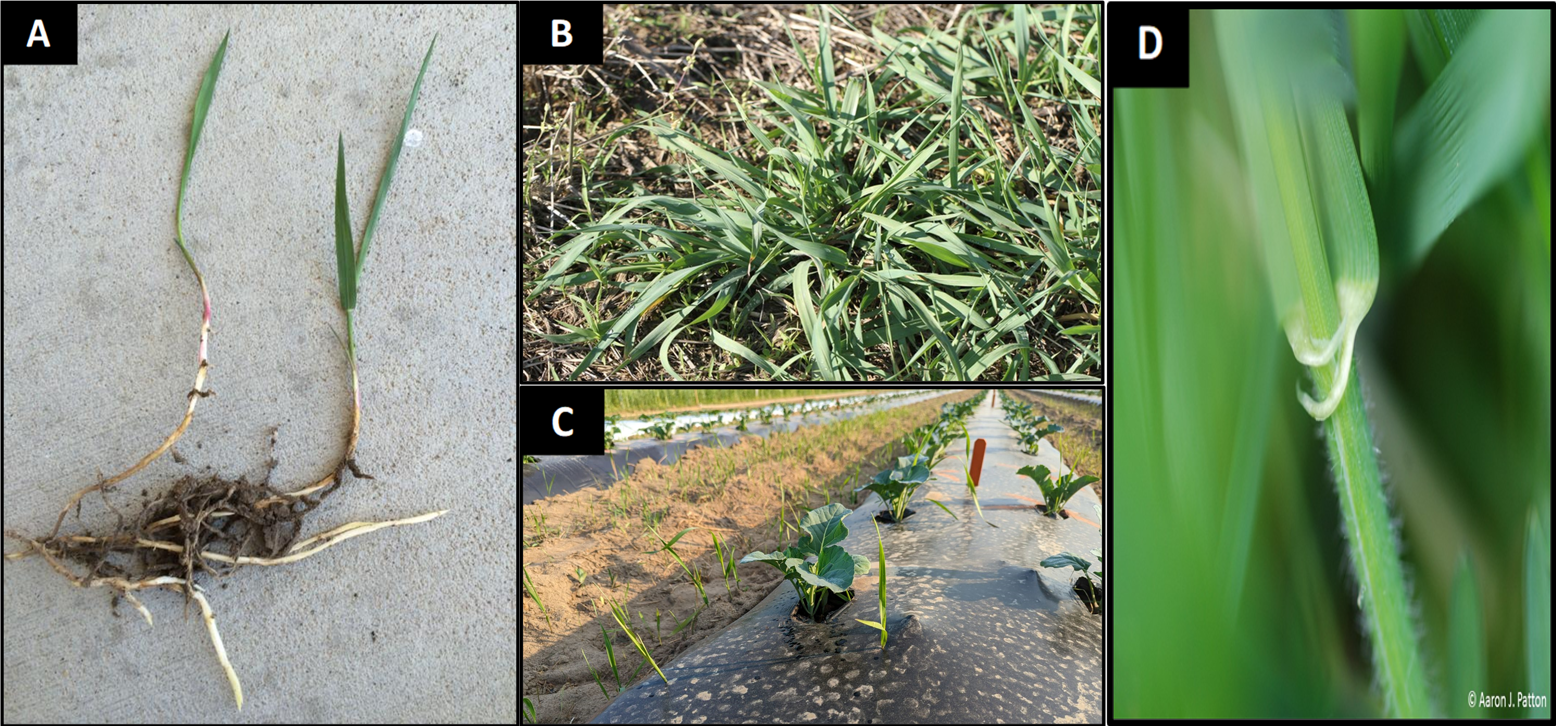
Vegetable transplants
Time spent looking over the general health of vegetable transplants prior to planting is a good investment. Transplants with signs of disease including leaf spots, stem girdling, discolored or sloughing roots should not be planted in the field. It's tempting to assume they will outgrow the problem once they are in the field, but this isn’t always the case. Additionally, diseased transplants can serve as a source of inoculum for disease spread in the field.
Crop updates
Asparagus
The abnormally dry conditions for this time of year paired with forecasted temperatures in the 80s suggest growers with irrigation should consider using it. Previous and ongoing MSU research on sandy soils has shown that overhead irrigation during hot and dry conditions of harvest can slow spear growth, helping harvest crews keep pace and improving spear tip quality. Given the dry spring and lack of rain in the forecast, growers should also consider “watering up” as needed to ensure adequate moisture prior to fern growth. Maintaining adequate moisture throughout the summer will improve fern productivity and carbohydrate storage in roots, which has been demonstrated to increase yields of Millennium in Michigan.
Want to store asparagus in times of high yields? Here are some lessons from past experience and recent research:
- Store the pick of the picks: High quality asparagus, with tight tips, etc., will last longer in storage.
- Early harvests may store better than later ones.
- Cut spears may store better than snapped ones.
- Asparagus that is promptly hydrocooled will last longer.
- Controlled atmosphere (CA) storage (11% O2, 10% CO2) may extend shelf life by about a week, but of course there is risk with a new practice like this.
Common asparagus beetles were more active this week in hotspots with the warmer temperatures. The other insect pest that could become active is dark-sided cutworm, which feeds at spear bases to cause crooking. Permethrin could be tank-mixed with carbaryl to spice up the spray and hit both beetles and cutworms; just note cutworm has historically been a spotty issue.
Carrots
Processing carrots were up in west central Michigan. Sowing was ongoing for fresh markets. Stands are decent, especially in early plantings that had good soil moisture. Growers have been focusing on early weed control.
The aster leafhopper “sweepstakes” is starting. The Szendrei lab at MSU partners with consultants and Michigan State University Extension to sweep fields for aster leafhoppers each week, take them to the lab, and test them for aster yellows. Results are texted to growers. Please email Zsofia Szendrei at szendrei@msu.edu if you’d like to sign up for text alerts. An Oceana County leafhopper sample collected Monday, May 22, had 0% infectivity.
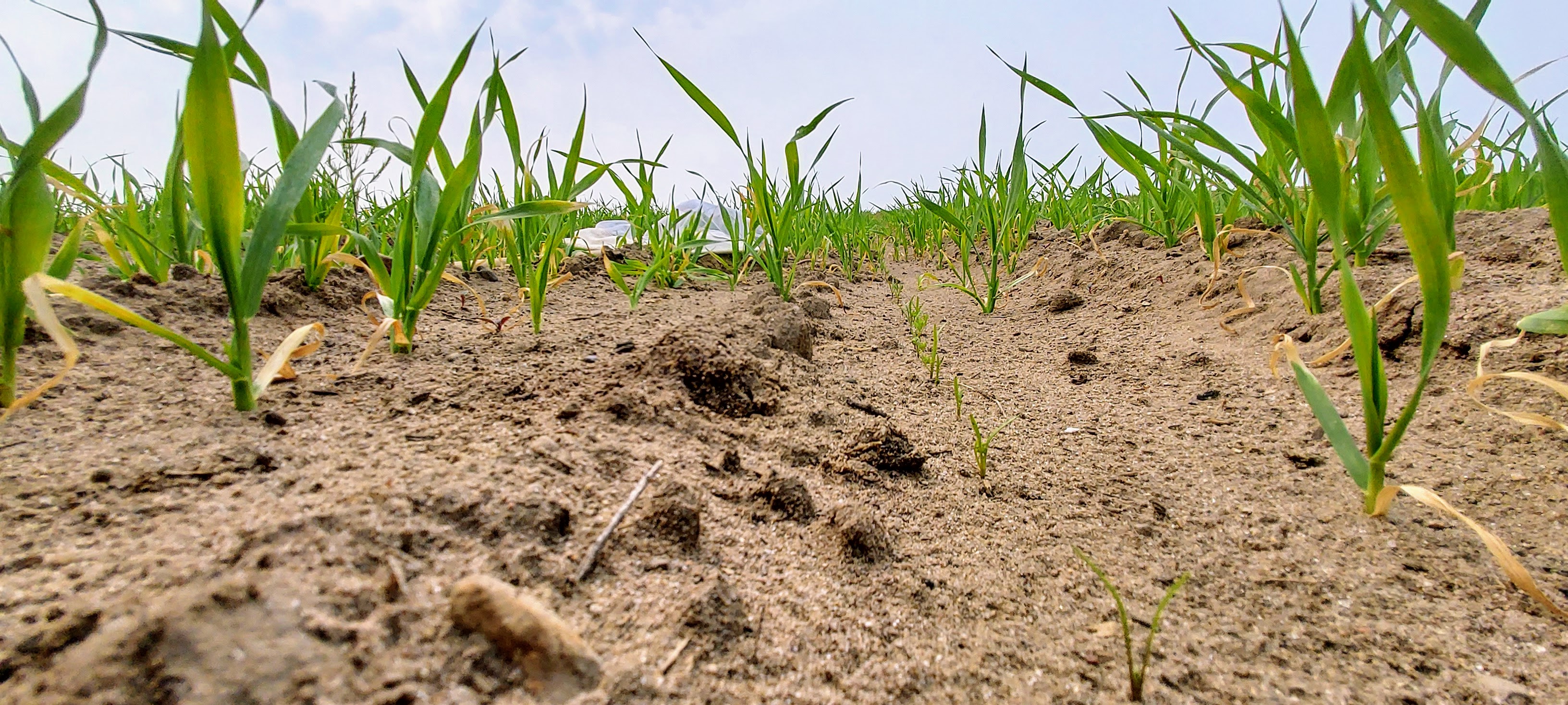
Cole crops and leafy greens
Cabbage and other brassicas and freeze-tolerant leafy greens have been planted since the beginning of April in the southern-tier counties of Michigan. Cultivation is occurring in early brassica plantings, along with overhead irrigation on some southwest Michigan farms. Hoophouse produced greens, including spinach, lettuce and chard have been going to market in some scenarios.
Diamondback moths showed up in traps in southwest Michigan this week and cabbage white butterflies, also known as imported cabbage worm, are likely flying. Bt can be effective when caterpillars are small and conserves beneficials that help control other pests. Read more about using Bt.
Check out the new, online cabbage maggot predictor tool! It’s revamped to make it easier to digest at a glance where things stand.
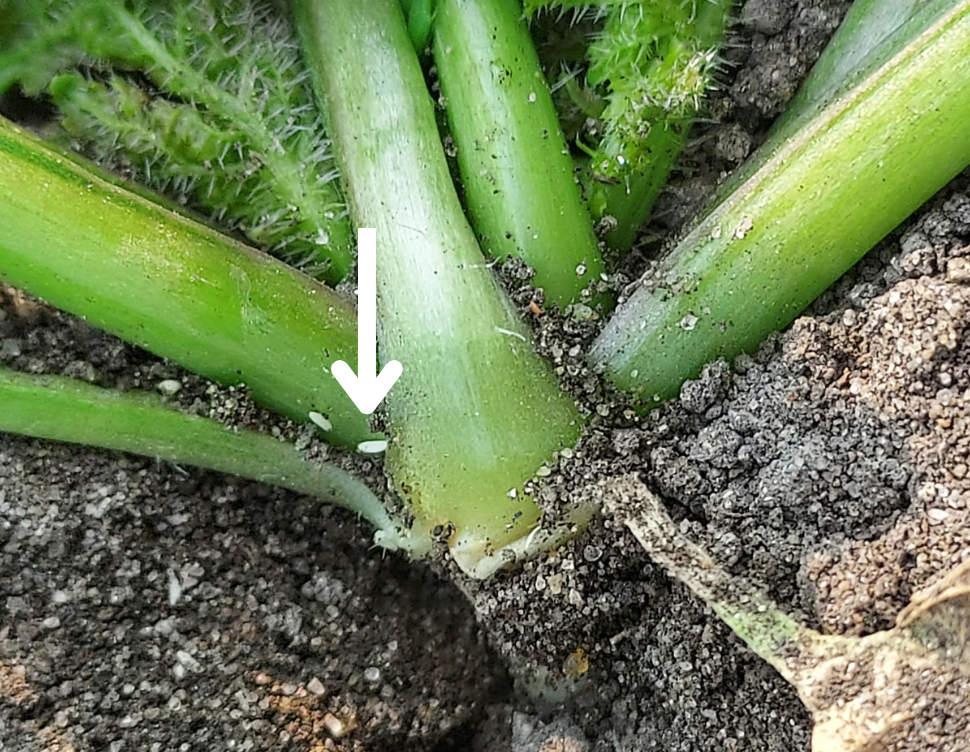
Cabbage maggot eggs and damage continued to be present in fields with a population of this pest and begun to show up in more northerly areas over the past week. Degree day models predict we are about at peak for the spring flight. Check out the May 10 Michigan vegetable crop report for information on control, as well as this factsheet for direct sown brassicas.
Transplanted brassicas—cabbage, broccoli, cauliflower—that survive the spring cabbage maggot flight will likely be just fine. In past years, what died, died early and the rest lived on just fine. Later plantings don’t seem to have issues. Issues can continue in direct-sown brassicas, like root crops, where minor root feeding is an aesthetic problem. This pest also seems to especially like Napa cabbage.
Cucurbits/pickles
Seedling cucumber and summer squash from the first plantings are up with true leaves in southwest Michigan. Cucurbit planting continues at a high rate across lower Michigan.
Weed control and crop safety are always questions with cucurbits. Check out this table by Sushila Chaudhari, which lists the options, their strengths and key notes. Also, check out this helpful article on weed control from Minnesota.
Seedcorn maggot is on organic growers’ minds as winter squash sowing tees up. Soil temperatures are a key risk factor; past research showed that risk is greatly reduced once soil temperatures at a 4-inch depth consistently hit 70 degrees Fahrenheit. Many MSU Enviroweather stations have soil temperature probes at this depth, just note they are often under turf.

Fruiting vegetables
Tomatoes, peppers and eggplants were being transplanted in southwest Michigan this week and are wrapping up on black plastic on some farms. They will be switching to planting on white-on-black plastic in the next couple weeks. Tomatoes at the Green Thumb Auction in Tuscola County went for $40 per 10-pound box this week. The Wakarusa Auction in northern Indiana moved the same product for $11. I think this demonstrates how regional markets can be very different from each other, and how earliness is valued differently by region.
Flea beetles tend to graze on eggplant and a whole host of cole crops. However, we have not seen them much this year in southwest Michigan. Instead, we’ve seen more damage on tomatoes and peppers than ever. It’s not much, it’s on the oldest growth, and we do not see many signs of further feeding.
As indeterminate hoophouse tomatoes grow, it is important to keep the lower stems tame for good airflow and disease management. One farm visit last week shared their current pruning status and we were happy to see clear through to the grass on the other side of the tunnel.
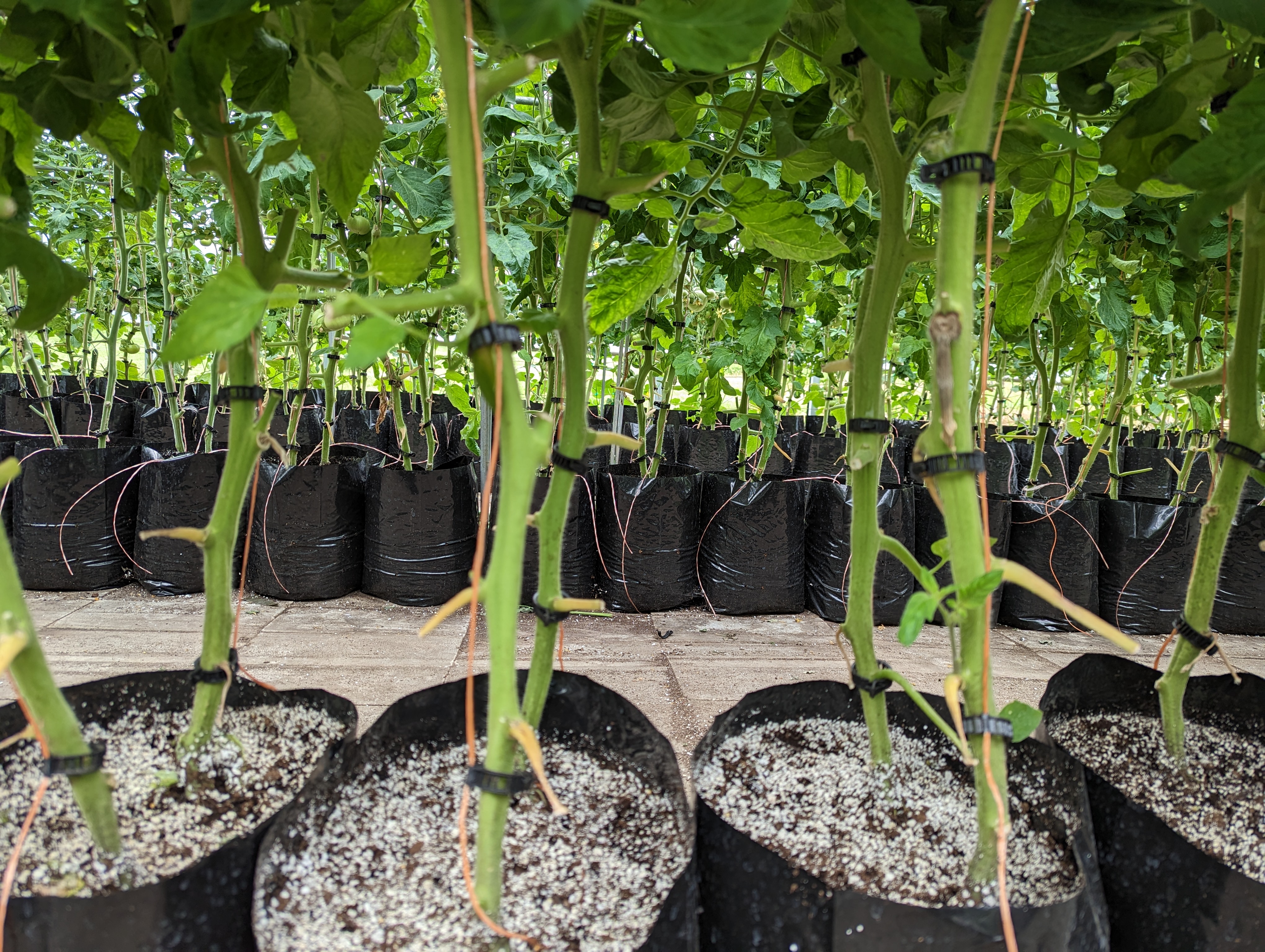
Onions
Sweet onions were being transplanted last week in southwest Michigan, with plans to plant more this week. Sweet onions started from seed in a greenhouse, and transplanted into plastic mulch, are a good match. But it depends on your skill, space or greenhouse connections for starting the seed, and what sort of transplanting system you have. Finger-style and carousel transplanters will not work on plastic mulch. Cup-style transplanters are a possibility, but waterwheels are the best option, and they also work on bare soil. You must also have a tractor with a creeper gear to go as slow as possible to maintain quality placement at high density, and a well-caffeinated driver.
One downside to plasticulture onions is the potential for the bulb to grow under the plastic and press up into it from below. With the relatively weak shade from an onion canopy and wide bed spacings, this can sometimes result in scalding damage to the outer bulb sheath on prolonged sunny days on south- and west-facing rows.

Rhubarb
Rhubarb harvest has started in southern Michigan. Thinking along a longer timeline can be advantageous when growing perennial vegetables like rhubarb or asparagus. It is important to strike a balance between yield and allowing the plant to conserve energy and build up its root system for the following seasons. Like asparagus, common practice is to begin rhubarb harvest at three years after planting one-year-old crowns. Allowing the rhubarb to dedicate photosynthates to developing a strong, established root system in the first few years will be beneficial to the long-term productivity and longevity of the plant.
Sweet corn
Seedings continue. Irrigation considerations will affect emergence and growth.
Strawberries
Early sites where strawberries are being grown on plastic mulch started harvesting on Monday this week. Matted row crops are sizing berries.
Events
- May 18, 7–8 a.m., Field Crops Virtual Breakfast: Dry Bean Planting
- May 22, 5:30-7 p.m., Monday Night Southwest Michigan Fruit IPM Meeting
- May 25, 7–8 a.m., Field Crops Virtual Breakfast: Plant & Pest Diagnostics - Know Your Problems
- June 1, 7–8 a.m., Field Crops Virtual Breakfast: Wildlife Management
- June 5, 5:30-7 p.m., Monday Night Southwest Michigan Fruit IPM Meeting
- June 8, 7–8 a.m., Field Crops Virtual Breakfast: Q & A "Hot Topics"
- June 12, 5:30-7 p.m., Monday Night Southwest Michigan Fruit IPM Meeting
- June 15, 7–8 a.m., Field Crops Virtual Breakfast: White Mold Management In Soybean
- June 19, 5:30-7 p.m., Monday Night Southwest Michigan Fruit IPM Meeting
- June 26, 5:30-7 p.m., Monday Night Southwest Michigan Fruit IPM Meeting
- June 28, 9:30 a.m.-3 p.m., MSU Weed Tour 2023
- June 29, 7–8 a.m., Field Crops Virtual Breakfast: Cercospora Leaf Spot Management In Sugar Beets
- July 6, 7–8 a.m., Field Crops Virtual Breakfast: Strategies For Efficient Irrigation Water Use
- July 13, 7–8 a.m., Field Crops Virtual Breakfast: Cover Crops After Wheat
- July 20, 7–8 a.m., Field Crops Virtual Breakfast: Tar Spot
- July 20, 9 a.m. - 1:30 p.m., In-Field and Edge-of-Field Conservation Practice Field Day (more information to come)
- July 27, 7–8 a.m., Field Crops Virtual Breakfast: Bugs And More Bugs!
- August 3, 7–8 a.m., Field Crops Virtual Breakfast: Farm & Truck Vehicle Regulations And Safety
- August 10, 7–8 a.m., Field Crops Virtual Breakfast: How To Get The Best Out Of Your Drainage System
- August 17, 7–8 a.m., Field Crops Virtual Breakfast: "Hot Topic" Q & A Session
- August 24, 7–8 a.m., Field Crops Virtual Breakfast: Timing The Last Irrigation Application
- August 31, 7–8 a.m., Field Crops Virtual Breakfast: Setting The Stage For Record Breaking Wheat Yields
- September 7, 7–8 a.m., Field Crops Virtual Breakfast: Marketing Your Grain Crops
- September 14, 7–8 a.m., Field Crops Virtual Breakfast: Monitoring Nematode Resistance In Soybeans
- September 21, 7–8 a.m., Field Crops Virtual Breakfast: Fall Weed Control
This work is supported by the Crop Protection and Pest Management Program [grant no 2021-70006-35450] from the USDA National Institute of Food and Agriculture. Any opinions, findings, conclusions, or recommendations expressed in this publication are those of the author(s) and do not necessarily reflect the view of the U.S. Department of Agriculture.



 Print
Print Email
Email

